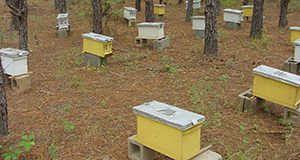
This 9-page illustrated fact sheet by James D. Ellis discusses the merits of using nucleus colonies, or nucs, which are smaller versions of full-sized Langstroth hives. The publication explains how to create and manage nucs and how to use them to control swarming, strengthen production colonies, re-queen hives, hive swarms, produce queens to sell to other beekeepers, and in general strengthen and expand a beekeeping operation. Published by the UF Department of Entomology and Nematology.
http://edis.ifas.ufl.edu/in869
Tag: Beekeeping
Keeping Bees in Florida
As of June 2016, there are over 4,000 registered beekeepers in the state of Florida and 440,000 managed colonies. According to the USDA, 2012 Florida beekeepers produced over 11 million pounds of honey. The average winter colony loss in Florida as reported by the Bee Informed Partnership Management Survey was the third lowest rate across the nation with only Hawaii and Texas reporting lower colony losses in that time period. This 4-page fact sheet written by Tomas A. Bustamante, Jamie D. Ellis, and Mary Bammer and published by the UF Department of Entomology and Nematology gives an overview of what makes Florida a unique state in which to keep honey bees. It explains the ins and outs of beekeeping in Florida, with descriptions of some of the hazards, a few of the important nectar-producing plants, special considerations for seasonal colony growth and management, and Florida beekeeping regulations.
http://edis.ifas.ufl.edu/aa264
The Social Organization of Honey Bees

A honey bee colony is a superorganism, which means that together its members function like a single animal. Bees within a colony work together like the cells in a human body. They warm the colony in the winter by vibrating their wings to generate heat and cool it in the summer by ferrying in droplets of water and fanning air over them. Worker bees fan air into and out of the colony entrance in distinct inhalations and exhalations. Colonies reproduce by swarming to create new daughter colonies that in turn thermoregulate, breathe, and reproduce just as a single autonomous animal does. In three pages this fact sheet explains the intricate caste system and age-based division of labor that allows colonies of humankind’s best-loved pollinators to function and thrive. Written by Ashley N. Mortensen, Bryan Smith, and James D. Ellis and published by the Entomology and Nematology Department.
http://edis.ifas.ufl.edu/in1102
Observation Bee Hives
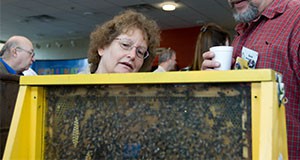
The use of observation bee hives continues to interest a variety of people. This is not surprising. The observation hive is one of the primary research and educational tools in apiculture. It is both educational and entertaining. Observation bee hives can be used to enhance public relations and marketing programs. But a great deal of time and energy is needed to set up a hive and keep it going. Maintenance can be expensive and time consuming, especially if the hive is to be used as a permanent display for the general public. This 3-page fact sheet provides sources for building observation hives and tips for maintenance. Written by David Hall, James D. Ellis, and Malcolm Sanford, and published by the UF Department of Entomology and Nematology, March 2015. (UF/IFAS photo by Tyler Jones)
http://edis.ifas.ufl.edu/mg320
Sample Pollination Agreement
 The key to a prospering pollination service is proper promotion, honest, quality service, and a written contract. This contract would detail the expectations of both the beekeeper and the grower. This 4-page fact sheet provides a suggested pollination agreement. Written by Malcolm T. Sanford, Jeanette Klopchin, and James Ellis, and published by the UF Department of Entomology and Nematology, March 2015. (UF/IFAS Photo: Thomas Wright)
The key to a prospering pollination service is proper promotion, honest, quality service, and a written contract. This contract would detail the expectations of both the beekeeper and the grower. This 4-page fact sheet provides a suggested pollination agreement. Written by Malcolm T. Sanford, Jeanette Klopchin, and James Ellis, and published by the UF Department of Entomology and Nematology, March 2015. (UF/IFAS Photo: Thomas Wright)
http://edis.ifas.ufl.edu/aa169
Robbing Behavior in Honey Bees
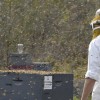 Western honey bee workers can invade and steal honey/nectar from other colonies or sugar/corn syrup from feeders used to deliver syrup to other colonies. This is called “robbing” behavior. Robbing behavior typically involves the collection of nectar and honey, but not pollen or brood. Some beekeepers report that robbing bees may steal wax or propolis from other hives, but there is not much data available on this occurrence. Robbing behavior can escalate quickly from just a few bees robbing other colonies to a massive frenzy of bees robbing many colonies in an apiary. This 3-page fact sheet was written by Ryan Willingham, Jeanette Klopchin, and James Ellis, and published by the UF Department of Entomology and Nematology, February 2015. (Photo Credit: UF/HBREL)
Western honey bee workers can invade and steal honey/nectar from other colonies or sugar/corn syrup from feeders used to deliver syrup to other colonies. This is called “robbing” behavior. Robbing behavior typically involves the collection of nectar and honey, but not pollen or brood. Some beekeepers report that robbing bees may steal wax or propolis from other hives, but there is not much data available on this occurrence. Robbing behavior can escalate quickly from just a few bees robbing other colonies to a massive frenzy of bees robbing many colonies in an apiary. This 3-page fact sheet was written by Ryan Willingham, Jeanette Klopchin, and James Ellis, and published by the UF Department of Entomology and Nematology, February 2015. (Photo Credit: UF/HBREL)
http://edis.ifas.ufl.edu/in1064
Best Management Practices for Siting Honey Bee Colonies: Good Neighbor Guidelines
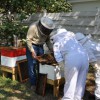 Keeping honey bees requires responsible management so that the bees do not become a nuisance. Additionally, the presence of Africanized honey bees in Florida places more pressure on beekeepers to maintain their colonies properly. This 3-page fact sheet is a reference for honey bee management in Florida, with emphasis on siting apiaries in sensitive locations, in order to promote harmonious cooperation between beekeepers, neighbors, and landowners. Written by Jamie Ellis, Jerry Hayes, and published by the UF Department of Entomology and Nematology, November 2014. (Photo by Thien Gretchen (CC BY-NC-ND 2.0), via Flickr)
Keeping honey bees requires responsible management so that the bees do not become a nuisance. Additionally, the presence of Africanized honey bees in Florida places more pressure on beekeepers to maintain their colonies properly. This 3-page fact sheet is a reference for honey bee management in Florida, with emphasis on siting apiaries in sensitive locations, in order to promote harmonious cooperation between beekeepers, neighbors, and landowners. Written by Jamie Ellis, Jerry Hayes, and published by the UF Department of Entomology and Nematology, November 2014. (Photo by Thien Gretchen (CC BY-NC-ND 2.0), via Flickr)
http://edis.ifas.ufl.edu/aa137
Minimizing Honey Bee Exposure to Pesticides
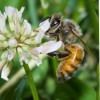 Protecting honey bees and other pollinators from pesticide impacts is important to the sustainability of agriculture. Consequently, pesticide applicators must determine if there is a clear hazard to managed or wild populations of bees. Potential exposure of bees to pesticides can vary greatly depending on the type of pesticide, formulation, application method, label restrictions, and other factors. The goal in using a pesticide is to achieve maximum benefit (success) with minimum negative impact, and these factors should always be considered in pesticide selection. This publication is written (1) to help assure the sustainability of both bees and agriculture by informing beekeepers, pesticide users, and the general public about the often complex relationship between pollinators (specifically bees) and pesticides, (2) to offer guidance for improved communication between beekeepers and pesticide users, (3) to offer pollinator risk-reducing strategies for growers and other applicators when using pesticides, and (4) to provide clarity in laws, labeling, and associated definitions. This 14-page fact sheet was written by J. D. Ellis, J. Klopchin, E. Buss, F. M. Fishel, W. H. Kern, C. Mannion, E. McAvoy, L. S. Osborne, M. Rogers, M. Sanford, H. Smith, P. Stansly, L. Stelinski, and S. Webb, and published by the UF Department of Entomology and Nematology, March 2014.
Protecting honey bees and other pollinators from pesticide impacts is important to the sustainability of agriculture. Consequently, pesticide applicators must determine if there is a clear hazard to managed or wild populations of bees. Potential exposure of bees to pesticides can vary greatly depending on the type of pesticide, formulation, application method, label restrictions, and other factors. The goal in using a pesticide is to achieve maximum benefit (success) with minimum negative impact, and these factors should always be considered in pesticide selection. This publication is written (1) to help assure the sustainability of both bees and agriculture by informing beekeepers, pesticide users, and the general public about the often complex relationship between pollinators (specifically bees) and pesticides, (2) to offer guidance for improved communication between beekeepers and pesticide users, (3) to offer pollinator risk-reducing strategies for growers and other applicators when using pesticides, and (4) to provide clarity in laws, labeling, and associated definitions. This 14-page fact sheet was written by J. D. Ellis, J. Klopchin, E. Buss, F. M. Fishel, W. H. Kern, C. Mannion, E. McAvoy, L. S. Osborne, M. Rogers, M. Sanford, H. Smith, P. Stansly, L. Stelinski, and S. Webb, and published by the UF Department of Entomology and Nematology, March 2014.
http://edis.ifas.ufl.edu/in1027
Florida Master Beekeeper Program Requirements
 The Master Beekeeper Program (MBP) is a five-year (minimum) beekeeper training and certification program provided by the University of Florida. One must already be a beekeeper to enter the program. This 22-page fact sheet was written by James Ellis, Jerry Hayes, Catherine Zettel Nalen, William H. Kern, Ray Zerba, Brad Burbaugh, and Jeanette Klopchin, and published by the UF Department of Entomology and Nematology, October 2013.
The Master Beekeeper Program (MBP) is a five-year (minimum) beekeeper training and certification program provided by the University of Florida. One must already be a beekeeper to enter the program. This 22-page fact sheet was written by James Ellis, Jerry Hayes, Catherine Zettel Nalen, William H. Kern, Ray Zerba, Brad Burbaugh, and Jeanette Klopchin, and published by the UF Department of Entomology and Nematology, October 2013.
http://edis.ifas.ufl.edu/in847
Overwintering Honey Bee Colonies in Northern Climates
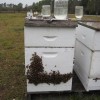 One of the many challenges beekeepers face is minimizing honey bee colony losses during winter. This can be especially challenging to beekeepers in extreme northerly climates. Special preparations must be made during the fall to ensure that colonies survive the winter months with minimal loss. This 3-page fact sheet was written by James D. Ellis and Katherine Hammons, and published by the UF Department of Entomology and Nematology, September 2013.
One of the many challenges beekeepers face is minimizing honey bee colony losses during winter. This can be especially challenging to beekeepers in extreme northerly climates. Special preparations must be made during the fall to ensure that colonies survive the winter months with minimal loss. This 3-page fact sheet was written by James D. Ellis and Katherine Hammons, and published by the UF Department of Entomology and Nematology, September 2013.
http://edis.ifas.ufl.edu/in1006
Swarm Control for Managed Beehives (ENY160/IN970)
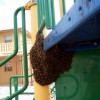 Honey bee swarms are a normal sign of a productive and strong honey bee colony. The population of honey bees in the environment grows and genes are exchanged as the new queen in the parent colony mates with drones from other colonies in the surrounding environment. Unfortunately, this activity often conflicts with the goals of the beekeeper, so good colony management includes swarm prevention. During the swarm season, hive owners should undertake proactive beekeeping practices to alter colonies in response to potential swarming behavior. In this way, the beekeeper maintains strong colonies with greater honey production and the potential to split and increase the total number of colonies, all of which makes beekeeping much more profitable for hive owners. This 6-page fact sheet was written by Sara DeBerry, John Crowley, and James D. Ellis, and published by the UF Department of Entomology and Nematology, November 2012.
Honey bee swarms are a normal sign of a productive and strong honey bee colony. The population of honey bees in the environment grows and genes are exchanged as the new queen in the parent colony mates with drones from other colonies in the surrounding environment. Unfortunately, this activity often conflicts with the goals of the beekeeper, so good colony management includes swarm prevention. During the swarm season, hive owners should undertake proactive beekeeping practices to alter colonies in response to potential swarming behavior. In this way, the beekeeper maintains strong colonies with greater honey production and the potential to split and increase the total number of colonies, all of which makes beekeeping much more profitable for hive owners. This 6-page fact sheet was written by Sara DeBerry, John Crowley, and James D. Ellis, and published by the UF Department of Entomology and Nematology, November 2012.
http://edis.ifas.ufl.edu/in970
Florida Bears and Beekeeping (ENY105/AA133)
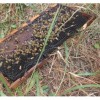 The Florida black bear (Ursus americanus floridanus) is a minor predator of beehives in Florida with the potential to cause major destruction. Large-scale urban and agricultural development inexorably reduces prime bear habitat each year. This habitat also contains excellent bee forage, and so bears and bees will sometimes come in contact, thus resulting in bear predation. This 4-page fact sheet was written by Malcolm T. Sanford and James D. Ellis, and published by the UF Department of Entomology and Nematology, August 2012.
The Florida black bear (Ursus americanus floridanus) is a minor predator of beehives in Florida with the potential to cause major destruction. Large-scale urban and agricultural development inexorably reduces prime bear habitat each year. This habitat also contains excellent bee forage, and so bears and bees will sometimes come in contact, thus resulting in bear predation. This 4-page fact sheet was written by Malcolm T. Sanford and James D. Ellis, and published by the UF Department of Entomology and Nematology, August 2012.
http://edis.ifas.ufl.edu/aa133
Pesticide Effects on Nontarget Organisms (PI85/PI122)
Pesticides are an integral part of agriculture as Florida's climate fosters an environment conducive to major pest outbreaks throughout the entire year. Our environment also is favorable for the development and presence of beneficial organisms that positively affect our agricultural production and enhance our wildlife and plant communities. This revised 7-page guide addresses the effects of various types of pesticides on nontarget organisms, including natural enemies and beneficial organisms, such as honeybees, wildlife, fish, and nontarget plants. Written by Frederick M. Fishel, and published by the UF Department of Agronomy, April 2011.
http://edis.ifas.ufl.edu/pi122
ENY158/IN874 Explaining the Best Management Practices for Maintaining European Honey Bee Colonies
ENY158, a 4-page fact sheet by M. K. O’Malley, J.D. Ellis and G. W. Hayes, Jr., outlines and explains the 12 recommendations listed in the voluntary agreement between Florida beekeepers and state officials to minimize the spread of African honey bees. Published by the UF Department of Entomology and Nematology, October 2010.
http://edis.ifas.ufl.edu/in874
ENY157/IN872 Theft, Vandalism, and Other Related Crime in the Beekeeping Industry: A Guide for Beekeepers
ENY157, a 2-page fact sheet by C.M. Zettel Nalen and J.D. Ellis, provides recommendations for crime prevention in beekeeping operations, what to do if hives or equipment are stolen or vandalized, and resources for beekeepers. Published by the UF Department of Entomology and Nematology, September 2010.
http://edis.ifas.ufl.edu/in872
ENY152/IN868 The Benefits of Pollen to Honey Bees
ENY152, a 4-page illustrated fact sheet by Amanda Ellis, Jamie Ellis, Michael O’Malley and Catherine Zettel Nalen, provides an overview of the nutritional needs of honey bees with an emphasis on the role of pollen — nutritional content, where it is produced, how it is collected, and how to ensure colony nutrition. Published by the UF Department of Entomology and Nematology, September 2010.
http://edis.ifas.ufl.edu/in868
ENY150/IN720: Colony Collapse Disorder (CCD) in Honey Bees
Revised! ENY-150, a 5-page illustrated fact sheet by Jamie Ellis, explains what is known about about this problem threatening the beekeeping industry in the U.S. — its symptoms, theories about its cause, how it affects the general public, what’s being done, and management recommendations for beekeepers. Includes selected references. Published by the UF Department of Entomology and Nematology, July 2010.
http://edis.ifas.ufl.edu/in720
ENY155/IN847 Florida Master Beekeeper Program Requirements
ENY155, a 9-page fact sheet by James Ellis, Jerry Hayes, Catherine Zettel Nalen, William H. Kern, Ray Zerba, and Brad Burbaugh, describes the requirements for this beekeeper training and certification program provided by the University of Florida. Published by the UF Department of Entomology and Nematology, May 2010.
http://edis.ifas.ufl.edu/in847
ENY156/IN848 Florida Beekeeping Management Calendar
ENY156, a 7-page fact sheet by J.D. Ellis and C.M. Zettel Nalen, provides Florida beekeepers a reference for honey bee colony management with specific guidance for region by month, including recommendations for major management considerations and blooming plants. Includes reference. Published by the UF Department of Entomology and Nematology, May 2010.
http://edis.ifas.ufl.edu/in848
ENY147S/IN863 Diferencias Entre Abejas Melíferas Europeas y Africanas
ENY-147S, a 3-page illustrated fact sheet by M. K. O’Malley, J. D. Ellis, C. M. Zettel Nalen and Pablo Herrera, is the Spanish language version of ENY147/IN784 Differences between European and African Honey Bees. It describes key differences between these two sub-species of Apis mellifera in their hive defense and stinging, swarming and absconding, and selection of nesting site. Includes references. Published by the UF Department of Entomology and Nematology, August 2010.
http://edis.ifas.ufl.edu/in863